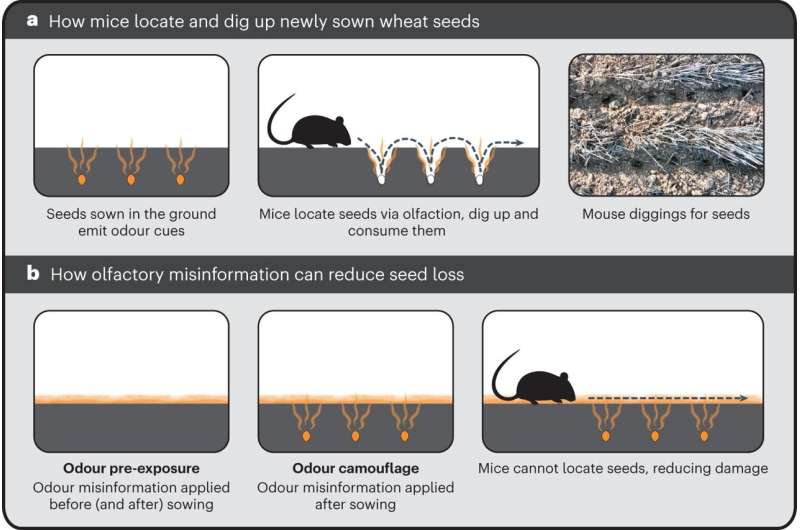A new approach to warding off mice eating wheat seed using camouflage scents

A team of life and environmental scientists from The University of Sydney has found that spraying wheat fields with wheat germ oil after seeding deters mice that feed on seeds. In their study, reported in journal Nature Sustainability, the group tested a technique first used in New Zealand to protect endangered birds.
Farmers have been attempting to outmaneuver field mice for centuries—mice like to eat grains, whether stored or in the ground in the form of seeds. Prior research has found that they consume approximately 70 million tons of maize, rice and wheat grains each year around the globe. Unfortunately, despite massive efforts to deter the rodents, farmers still must rely on poisons, and in some cases, cats. In this new effort, the researchers may have found a better option.
The researchers noted that colleagues in New Zealand had tried smearing the scents of endangered birds over areas where the birds would never visit. This led to predators growing suspicious of such scents, because when followed, there was no payoff. That led them to ignore the smell of the birds even when they were present.
To see if the approach might work with mice, the team treated 60 10×10 plots with wheat germ oil, which contains the scent of the wheat germ—the part of the wheat the mice want to eat. To gauge its effectiveness, the team sprayed it on plots before planting seeds and others after seeding. They also left a few plots untreated.
They were surprised to find that the oil did not serve as a false signal; the mice still ate the seeds where the plots had been pretreated. But they also found that the mice largely left alone the plots where treatment had occurred after planting. This, the researchers suggest, was likely because an overabundance of aroma had confused the mice, making it nearly impossible for them to find the seeds.
More information:
Finn C. G. Parker et al, Olfactory misinformation reduces wheat seed loss caused by rodent pests, Nature Sustainability (2023). DOI: 10.1038/s41893-023-01127-3
© 2023 Science X Network
Citation:
A new approach to warding off mice eating wheat seed using camouflage scents (2023, May 23)
retrieved 23 May 2023
from https://phys.org/news/2023-05-approach-warding-mice-wheat-seed.html
This document is subject to copyright. Apart from any fair dealing for the purpose of private study or research, no
part may be reproduced without the written permission. The content is provided for information purposes only.
For all the latest Science News Click Here
For the latest news and updates, follow us on Google News.

